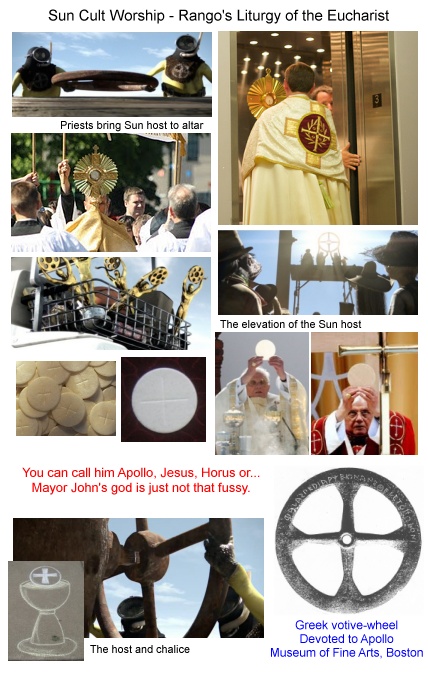 I've covered a lot of ground on this subject matter already in several of the Rango posts and in a study posted recently titled Ash Wednesday - A "Fourth Day" Ritual Prefiguring the Mark of the Beast, but there's still more to bring forth. This is not a rehash, so what follows might not make much sense if you're not already somewhat familiar with this background material.
I've covered a lot of ground on this subject matter already in several of the Rango posts and in a study posted recently titled Ash Wednesday - A "Fourth Day" Ritual Prefiguring the Mark of the Beast, but there's still more to bring forth. This is not a rehash, so what follows might not make much sense if you're not already somewhat familiar with this background material.I'm going to address two scenes that make reference to Ash Wednesday. The one that happens first in the movie is easier to recognize if you understand the second, so I'll cover the second one first, the hydration ceremony.
I can't point you to a video clip of this scene. If you can find one or post one, please share the link with me. If you are already familiar with the Romish style Mass and Ash Wednesday ritual it might help you grasp what I'm going to present, but might also hinder you. If you feel yourself wanting to defend anything it's a sign that there's some personal issue you haven't fully resolved. I pray those of you who read here and are offended in some way take the matter up with the Lord without hesitation. I'll be using the Romish labels for reference but I don't mean to imply by this convenience that there's any legitimacy to their labeling.
 You may want to spend some time meditating on the meaning of the images in this collection I assembled for comparison.
You may want to spend some time meditating on the meaning of the images in this collection I assembled for comparison. The Wednesday hydration ceremony resembles the Romish church's Ash Wednesday Mass, presenting a series of elements that are common to many Catholic and Protestant services. It starts out like every Mass, then the Ash Wednesday elements appear.
There's a call to worship rung out with the clock tower's bell chiming the Noon hour. Worshipers arrive in a sober, orderly fashion, passing the graveyard on the way, which is a feature common to many church properties. We hear music while they become a congregation, quietly facing Mayor John, the officiating priest. He formerly welcomes everyone. Then he calls to the priests to "Prepare the holy spigot!"
We are about to see the Romish Liturgy of the Eucharist followed by Holy Communion. The Sun cult priests ascend the platform with the spigot handle to arrive at the altar, which is the procession of priests bringing the host to the altar. I infer that they bless it silently in the prescribed manner. They fit the spigot handle-host to the water pipe-chalice. The Eucharist is ready.
Mayor John speaks and the congregation responds.
Mayor John: “The time has come my friends, the time that was foretold,”
Congregation Response: “Hallelujah”
This actually anticipates the fulfillment of what is prophesied in Mass and Ash Wednesday's ritual.
Mayor John continues.
Mayor John: “the sacred time,”
Congregation Response: “Hallelujah”
When Mayor John says “the sacred time,” the priests fit the handle-host to the spigot-chalice to make the parts a viable valve, so the sacred time is of course marking the mystical transubstantiation.
The officiating priest continues.
Mayor John: “the time of destiny,”
Congregation Response: “Hallelujah”
Communion rite
“All together recite or sing the "Lord's Prayer" ("Pater Noster" or "Our Father"). The priest introduces it with a short phrase and follows it up with the embolism: "Deliver us, Lord, from every evil, and grant us peace in our day.”
Mayor John: “the time of deliverance.”
Congregation Response: “Hallelujah”
After the “deliverance” part in the liturgy, the next item on the agenda is Holy Communion. So far, this is a pretty generic Mass sequence. What happens next is where the Ash Wednesday signaling begins, and where it begins to get very specific and pronounced!
Mayor John: “It is the time of hydration!”
At those words, the priests open the valve of the holy spigot, beginning to administer the Blessed Sacrament (that is to dispense/distribute the bread and wine mixed with water) to the first worshiper. Administering the sacrament shouldn't cause the congregation to make a fuss but something is not right.
 Pure water is expected to flow out of the spigot into Rango's cup, but mud comes out instead. (Note: When worshipers get the mark of the Beast it will be a worse disappointment.) This is not your regular Mass. With mud splashing even on Rango's forehead, it has become Ash Wednesday's ritual marking with wet ash. What is mud but wet dirt, and what is dirt but dust and ash and such. “Ashes to ashes and dust to dust” is an expression that would certainly have been heard at services in the graveyard they passed earlier.
Pure water is expected to flow out of the spigot into Rango's cup, but mud comes out instead. (Note: When worshipers get the mark of the Beast it will be a worse disappointment.) This is not your regular Mass. With mud splashing even on Rango's forehead, it has become Ash Wednesday's ritual marking with wet ash. What is mud but wet dirt, and what is dirt but dust and ash and such. “Ashes to ashes and dust to dust” is an expression that would certainly have been heard at services in the graveyard they passed earlier. The hydration references mixing the water with the ash, so Mayor John's pronouncement of the time of hydration introduces the Ash Wednesday ritual. The distribution of mud on the worshiper's forehead is not the usual bread and wine deal, with one given independent of the other. It's the Ash Wednesday Mass, and some of the following elements validate this observation.
One of the shocked members of the congregation can be heard saying, “Burn him!” Burning Rango would turn him into ashes! The suggestion to burn Rango alludes to the palm branches burned to make the ash, which would have been collected from the previous Palm Sunday. (This further identifies him as one of the palms to be burnt, one of the wicked, trampled at Y'shua's return in judgment as the palm branches strewn in the road were trampled into the dust when Y'shua rode the donkey/colt towards Jerusalem.)
Mayor John responds in an effort to assert control. What he says makes it pretty clear what day it is on the Romish liturgical calendar.
Mayor John: “Times will be tough from now on. Sacrifices will have to be made. But if I can help in any way please know that my door is always-”
Beans steps forward and interrupts, cutting him off. Ash Wednesday marks the beginning of a season called Lent that concludes with Easter Sunday. I remember when I was young, the Catholic kids would return to school after getting marked and ask each other, “What are you giving up for Lent?” You see, sacrifices had to be made. That was their focus, what really impacted their lives. When Mayor John says times will be tough from now on and that sacrifices will have to be made he's alluding to Lent, which begins on Ash Wednesday!
About Mayor John's statement that his door is always- and we can infer “open,” given his official priestly role in the service and the stained glass windows in his office, that he's making an oblique reference to the door to the church as his door that is always open. His response, if you understand something about Neuro-Linguistic Programming (NLP) connects the tough times and sacrifices with the church and the services it provides. Yes, even those on Ash Wednesday and through the Lenten season.
There's more. This is where it really gets dialed in! To be continued, Lord willing.

No comments:
Post a Comment